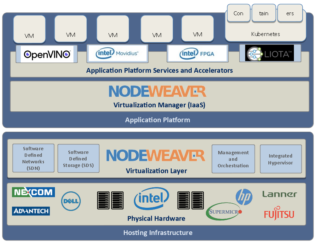When there is a message for me on LinkedIn, it’s almost always a recruiter or SEO marketer trying to sell me something. So, there was a pleasant surprise the other day when it was a marketing person for a software company with a new take on the Edge, datacenters, and software. That company is NodeWeaver.
Here is a statement of the problem. Most of the software in the world runs outside of clouds or datacenters—it runs at the edge. But the edge is made of small systems deployed in tens of thousands of locations, in stores, inside industrial systems, on top of telecom towers. Places that may have limited connectivity, or be difficult to reach, all sharing the fact that they run critical systems, and if something stops, your users are not getting services, or production lines grind to a halt. What happens if something fails?
Existing solutions require manual interventions by skilled technicians to resolve problems. They are complex and difficult to manage. They are difficult to scale to thousands of locations. What is needed has the flexibility of the cloud, but the ability to run everywhere, even on the smallest devices, and run without requiring user intervention.
That’s the idea behind NodeWeaver—a platform that runs any application and manages the distribution, control, and operation thanks to its intelligent autonomous system. Each system learns from what happens on all the others. It becomes smarter the more it expands and able to do more on its own.

NodeWeaver is a software defined operating platform that installs on the bare metal of nearly any x86 hardware and enables the deployment of highly resilient, agile and scalable compute clusters capable of running multiple virtual machines and container-based workloads, optimized for running workloads at the edge fully autonomously, integrating self-management, self-optimizing, self-healing features that dramatically reduces cost of ownership.
NodeWeaver nano clouds consist of 1 to 25 x86 compatible servers of any manufacturer/configuration, from very small to quite large. Connecting a new server to the nano cloud layer 2 switch automatically adds the server components to the virtual resource pool and relevels all applications across the updated server pool.
NodeWeaver delivers full datacenter infrastructure/functionality, optimized for running workloads at the edge, taking less than 1.3GB of RAM to provide all services, leaving the maximum amount of system resources available for actual workloads. NodeWeaver integrates orchestration, software-defined storage, software-defined networking, multiple hypervisors all managed by the intelligent autonomous system.
Customers who need to manage a large fleet of deployments already have their own monitoring framework in place. NodeWeaver has a full API that allows them to monitor (and manage) their edge systems using their existing monitoring framework. Tools like Ansible, Puppet, Chef, Terraform, and OneFlow Services are for operating system and application automation and management. NodeWeaver fully supports those as well, via a combination of pre-built Marketplace VMs (in the case of Terraform) or built-in services (OneFlow), or simply via API and network connection.
The NodeWeaver marketplace enables users to quickly download complete, pre-configured application stacks [including operating system] and service templates, using any of the software products in the catalog, and deploy them with minimal effort; automatically load balanced across nodes in a highly resilient, agile and scalable compute cluster capable of running multiple virtual machines and container-based workloads.
Industrial control systems used to drive production equipment in factories and plants were installed more than 20 years ago and are now becoming outdated, presenting major business challenges. While this infrastructure has provided a stable platform for control systems for many years, it lacks flexibility, requires costly manual maintenance, and does not easily allow process information to be exported and analyzed. Virtualization overcomes the limitations of legacy control systems infrastructure and provides the foundation for the Industrial Internet of Things (IIoT).
Control functions that were previously deployed across the network as dedicated hardware appliances can be virtualized and consolidated onto commercial off-the-shelf (COTS) servers, which not only leverages the most advanced silicon technology but also reduces capital expenditure, lowers operating costs, reduces risk, and improves ability to manage change and implement continuous improvement.
One of the leading providers of solutions for large-scale industrial laundry systems has been a NodeWeaver customer for over 2 years. They control and monitor all processes, provide predictive analytics, as well as automated deployment and management of all systems.
With no IT staff at these locations, system resiliency and the ability to autonomically address failures and maintain uptime is crucial. Additionally, the environments in these locations are characterized by high temperatures and humidity, thus requiring fanless, ruggedized hardware that can withstand these conditions.
NodeWeaver’s software-only approach provided the flexibility to choose the hardware necessary for the application, and its lightweight codebase enables it to run on smaller devices that competing solutions simply can’t support, equating to an unmatched combination of reliability, flexibility, and time to value.





